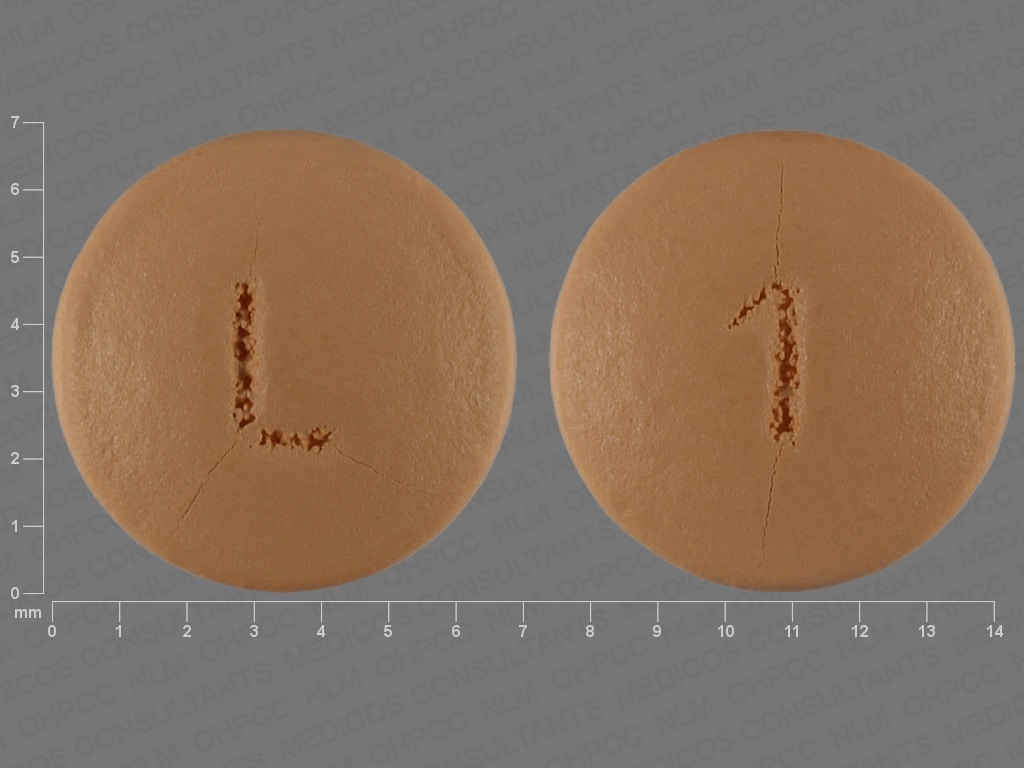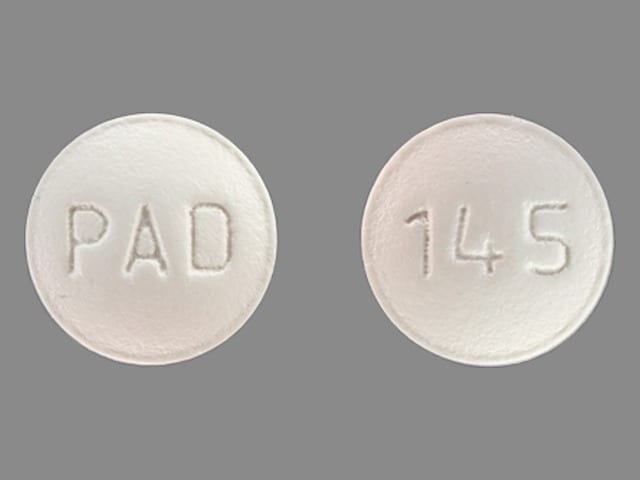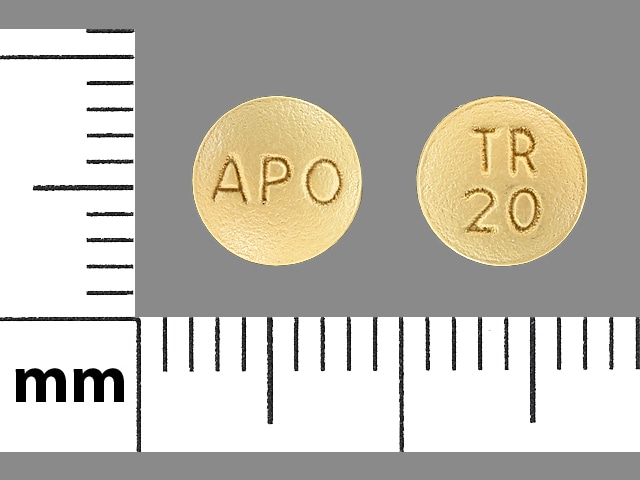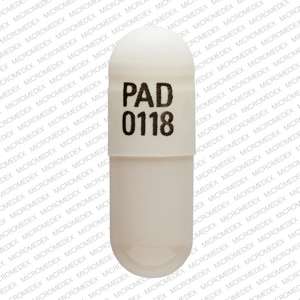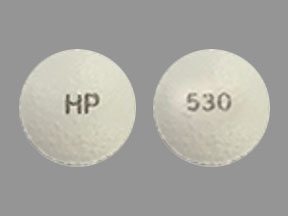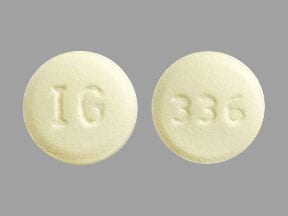Dosage Forms
Excipient information presented when available (limited, particularly for generics); consult specific product labeling.
Capsule Extended Release 24 Hour, Oral, as chloride:
Generic: 60 mg
Tablet, Oral, as chloride:
Generic: 20 mg
Pharmacology
Mechanism of Action
Trospium antagonizes the effects of acetylcholine on muscarinic receptors in cholinergically innervated organs. It reduces the smooth muscle tone of the bladder.
Pharmacokinetics/Pharmacodynamics
Absorption
<10%; decreased with a high-fat meal
Distribution
Vd: 395 to >600 L, primarily in plasma
Metabolism
Hypothesized to be via esterase hydrolysis and conjugation; forms metabolites
Excretion
Feces (85%); urine (~6%; mostly as unchanged drug) primarily via active tubular secretion
Time to Peak
5-6 hours
Half-Life Elimination
Immediate release formulation: 20 hours
Severe renal insufficiency (CrCl <30 mL/minute): ~33 hours; extended release formulation: ~35 hours
Protein Binding
48% to 85% in vitro
Use in Specific Populations
Special Populations: Renal Function Impairment
In patients with severe renal function impairment, there is a 4.2- and 1.8-fold increase in mean AUC and Cmax, respectively, and prolonged elimination t½.
Special Populations: Hepatic Function Impairment
In patients with mild or moderate hepatic impairment, the Cmax increased 12% and 63%, respectively (immediate release).
Special Populations: Gender
Pharmacokinetic data are conflicting. Exposure was 45% lower in elderly women compared with elderly men when a single 40 mg immediate-release dose was administered. AUC and Cmax were 26% and 68% higher, respectively, in women without hormone replacement therapy compared with men.
Use: Labeled Indications
Overactive bladder: Treatment of overactive bladder with symptoms of urgency, incontinence, and urinary frequency
Contraindications
Hypersensitivity to trospium or any component of the formulation; patients with or at risk of urinary retention, gastric retention, uncontrolled narrow-angle glaucoma
Dosage and Administration
Dosing: Adult
Overactive bladder: Oral:
Immediate release: 20 mg twice daily
Extended release: 60 mg once daily in the morning
Dosing: Geriatric
Elderly ≥75 years: Immediate release: Consider initial dose of 20 mg once daily (based on tolerability); Extended release: Refer to adult dosing.
Administration
Immediate release: Administer with water on an empty stomach at least 1 hour prior to meals.
Extended release: Administer in the morning with water on an empty stomach at least 1 hour before a meal.
Storage
Store at 20°C to 25°C (68°F to 77°F); excursions permitted between 15°C to 30°C (59°F to 86°F).
Trospium Images
Drug Interactions
Acetylcholinesterase Inhibitors: May diminish the therapeutic effect of Anticholinergic Agents. Anticholinergic Agents may diminish the therapeutic effect of Acetylcholinesterase Inhibitors. Monitor therapy
Aclidinium: May enhance the anticholinergic effect of Anticholinergic Agents. Avoid combination
Alcohol (Ethyl): May enhance the CNS depressant effect of Trospium. Alcohol (Ethyl) may increase the serum concentration of Trospium. Specifically, alcohol may increase the peak (maximum) serum concentration of trospium when consumed within 2 hours of taking extended-release trospium. Management: Avoid consuming any alcohol within 2 hours of taking a dose of trospium XR. Consider therapy modification
Amantadine: May enhance the anticholinergic effect of Anticholinergic Agents. Monitor therapy
Anticholinergic Agents: May enhance the adverse/toxic effect of other Anticholinergic Agents. Monitor therapy
Botulinum Toxin-Containing Products: May enhance the anticholinergic effect of Anticholinergic Agents. Monitor therapy
Cannabinoid-Containing Products: Anticholinergic Agents may enhance the tachycardic effect of Cannabinoid-Containing Products. Exceptions: Cannabidiol. Monitor therapy
Chloral Betaine: May enhance the adverse/toxic effect of Anticholinergic Agents. Monitor therapy
Cimetropium: Anticholinergic Agents may enhance the anticholinergic effect of Cimetropium. Avoid combination
Eluxadoline: Anticholinergic Agents may enhance the constipating effect of Eluxadoline. Avoid combination
Gastrointestinal Agents (Prokinetic): Anticholinergic Agents may diminish the therapeutic effect of Gastrointestinal Agents (Prokinetic). Monitor therapy
Glucagon: Anticholinergic Agents may enhance the adverse/toxic effect of Glucagon. Specifically, the risk of gastrointestinal adverse effects may be increased. Monitor therapy
Glycopyrrolate (Oral Inhalation): Anticholinergic Agents may enhance the anticholinergic effect of Glycopyrrolate (Oral Inhalation). Avoid combination
Glycopyrronium (Topical): May enhance the anticholinergic effect of Anticholinergic Agents. Avoid combination
Ipratropium (Oral Inhalation): May enhance the anticholinergic effect of Anticholinergic Agents. Avoid combination
Itopride: Anticholinergic Agents may diminish the therapeutic effect of Itopride. Monitor therapy
Levosulpiride: Anticholinergic Agents may diminish the therapeutic effect of Levosulpiride. Avoid combination
MetFORMIN: May decrease the serum concentration of Trospium. Monitor therapy
Mianserin: May enhance the anticholinergic effect of Anticholinergic Agents. Monitor therapy
Mirabegron: Anticholinergic Agents may enhance the adverse/toxic effect of Mirabegron. Monitor therapy
Nitroglycerin: Anticholinergic Agents may decrease the absorption of Nitroglycerin. Specifically, anticholinergic agents may decrease the dissolution of sublingual nitroglycerin tablets, possibly impairing or slowing nitroglycerin absorption. Monitor therapy
Opioid Agonists: Anticholinergic Agents may enhance the adverse/toxic effect of Opioid Agonists. Specifically, the risk for constipation and urinary retention may be increased with this combination. Monitor therapy
Oxatomide: May enhance the anticholinergic effect of Anticholinergic Agents. Avoid combination
Potassium Chloride: Anticholinergic Agents may enhance the ulcerogenic effect of Potassium Chloride. Management: Patients on drugs with substantial anticholinergic effects should avoid using any solid oral dosage form of potassium chloride. Avoid combination
Potassium Citrate: Anticholinergic Agents may enhance the ulcerogenic effect of Potassium Citrate. Avoid combination
Pramlintide: May enhance the anticholinergic effect of Anticholinergic Agents. These effects are specific to the GI tract. Consider therapy modification
Ramosetron: Anticholinergic Agents may enhance the constipating effect of Ramosetron. Monitor therapy
Revefenacin: Anticholinergic Agents may enhance the anticholinergic effect of Revefenacin. Avoid combination
Secretin: Anticholinergic Agents may diminish the therapeutic effect of Secretin. Management: Avoid concomitant use of anticholinergic agents and secretin. Discontinue anticholinergic agents at least 5 half-lives prior to administration of secretin. Consider therapy modification
Thiazide and Thiazide-Like Diuretics: Anticholinergic Agents may increase the serum concentration of Thiazide and Thiazide-Like Diuretics. Monitor therapy
Tiotropium: Anticholinergic Agents may enhance the anticholinergic effect of Tiotropium. Avoid combination
Topiramate: Anticholinergic Agents may enhance the adverse/toxic effect of Topiramate. Monitor therapy
Umeclidinium: May enhance the anticholinergic effect of Anticholinergic Agents. Avoid combination
Adverse Reactions
>10%: Gastrointestinal: Xerostomia (9% to 22%)
1% to 10%:
Cardiovascular: Tachycardia (<2%)
Central nervous system: Headache (4% to 7%), fatigue (2%)
Dermatologic: Skin rash (<2%), xeroderma
Gastrointestinal: Constipation (9% to 10%), abdominal pain (1% to 3%), dyspepsia (1% to 2%), flatulence (1% to 2%), abdominal distention (<2%), nausea (1%), dysgeusia, vomiting
Genitourinary: Urinary tract infection (1% to 7%), urinary retention (≤1%)
Infection: Influenza (2%)
Ophthalmic: Dry eye syndrome (1% to 2%), blurred vision (1%)
Respiratory: Nasopharyngitis (3%), dry nose (1%)
<1%, postmarketing, and/or case reports: Anaphylaxis, angioedema, back pain, chest pain, confusion, delirium, dizziness, drowsiness, fecal impaction, gastritis, hallucination, heat intolerance, hypertensive crisis, inversion T wave on ECG, palpitations, rhabdomyolysis, Stevens-Johnson syndrome, supraventricular tachycardia, syncope, visual disturbance
Warnings/Precautions
Concerns related to adverse effects:
- Angioedema: Cases of angioedema involving the face, lips, tongue, and/or larynx have been reported. Immediately discontinue if tongue, hypopharynx, or larynx are involved.
- CNS effects: May cause drowsiness, confusion, dizziness, hallucinations, and/or blurred vision, which may impair physical or mental abilities; patients must be cautioned about performing tasks which require mental alertness (eg, operating machinery or driving).
Disease-related concerns:
- Alzheimer's disease: Use with caution in patients with Alzheimer's disease.
- Bladder flow obstruction: Use with caution in patients with bladder flow obstruction; may increase the risk of urinary retention.
- Gastrointestinal obstructive disorders: Use with caution in patients with gastrointestinal obstructive disorders (ie, pyloric stenosis); may increase the risk of gastric retention.
- Glaucoma: Use with caution in patients with controlled (treated) narrow-angle glaucoma.
- Hepatic impairment: Use with caution in patients with moderate or severe hepatic impairment.
- Myasthenia gravis: Use with caution in patients with myasthenia gravis due to decreased GI motility.
- Renal impairment: Use immediate release formulation with caution in patients with renal impairment; dosage adjustment is required. Use of the extended release formulation is contraindicated in patients with severe renal impairment (CrCl <30 mL/minute).
- Ulcerative colitis: Use with caution in patients with ulcerative colitis due to decreased GI motility.
Concurrent drug therapy issues:
- Medications eliminated by active tubular secretion (ATS): ATS is a route of elimination; use caution with other medications that are eliminated by ATS (eg, procainamide, pancuronium, vancomycin, morphine, metformin, and tenofovir).
- Sedatives: Effects with other sedative drugs or ethanol may be potentiated.
Dosage form specific issues:
- Extended release: Ethanol should not be ingested within 2 hours of the administration of the extended release formulation; may increase incidence of drowsiness.
Monitoring Parameters
Anticholinergic effects (eg, dry mouth, constipation, dizziness); renal function; postvoid residual (PVR) urine volume and urinary tract infection prior to initiation of therapy (ACOG 2015)
Pregnancy
Pregnancy Risk Factor
C
Pregnancy Considerations
Adverse events were observed in animal studies.
Patient Education
What is this drug used for?
- It is used to treat an overactive bladder.
Frequently reported side effects of this drug
- Dry mouth
- Headache
Other side effects of this drug: Talk with your doctor right away if you have any of these signs of:
- Urinary tract infection like blood in the urine, burning or painful urination, passing a lot of urine, fever, lower abdominal pain, or pelvic pain.
- Dizziness
- Passing out
- Lack of sweat
- Fatigue
- Confusion
- Sensing things that seem real but are not
- Difficult urination
- Severe constipation
- Vision changes
- Eye pain
- Severe eye irritation
- Swelling in your throat
- Signs of a significant reaction like wheezing; chest tightness; fever; itching; bad cough; blue skin color; seizures; or swelling of face, lips, tongue, or throat.
Note: This is not a comprehensive list of all side effects. Talk to your doctor if you have questions.
Consumer Information Use and Disclaimer: This information should not be used to decide whether or not to take this medicine or any other medicine. Only the healthcare provider has the knowledge and training to decide which medicines are right for a specific patient. This information does not endorse any medicine as safe, effective, or approved for treating any patient or health condition. This is only a brief summary of general information about this medicine. It does NOT include all information about the possible uses, directions, warnings, precautions, interactions, adverse effects, or risks that may apply to this medicine. This information is not specific medical advice and does not replace information you receive from the healthcare provider. You must talk with the healthcare provider for complete information about the risks and benefits of using this medicine.
